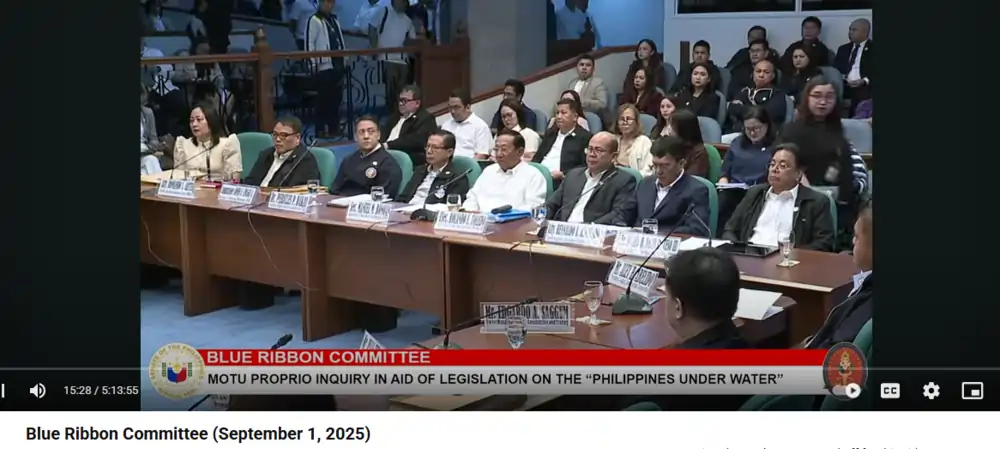Senate Blue Ribbon Hearing on Flood Control Projects: Key Highlights and Red Flags
The Senate Blue Ribbon hearing on September 1, 2025, chaired by Senator Rodante Marcoleta, became one of the most talked-about sessions of the year. At stake was the integrity of billions worth of flood control projects funded by public money. The hearing, broadcast live on the Senate of the Philippines YouTube channel, exposed a troubling mix of inconsistent testimonies, questionable ownership structures, and suspicions of systemic corruption.



For many Filipinos who followed the proceedings, the session reinforced a nagging reality: while projects are often justified as “nation-building,” the money trail tells another story. Observers noted evasive answers, ownership contradictions, and the apparent use of “dummy owners” to mask control over massive construction firms.
A detailed citizen commentary, also shared via Facebook by Vico Sotto, broke down the key moments and inconsistencies of the hearing.
The Changing Narrative of Madam Cezarah
One of the most striking parts of the hearing centered on Madam Cezarah, a figure tied to at least nine construction companies. Her testimony revealed a pattern of shifting statements depending on who was asking the questions.
- 1:05:37 – Sen. Erwin Tulfo’s questioning
She claimed she had already divested from most companies, remaining directly involved only with Alpha & Omega. She emphasized: “We are no longer part of those companies.” - 1:20:34 – Sen. Jinggoy Estrada’s questioning
In contrast, when asked directly whether she owned nine companies—St. Gerrard, St. Timothy, Alpha & Omega, Elite General Contractor, St. Matthew, Great Pacific Builders, YPR General Contractor, Amethyst Horizon Builders, and Waymaker OPC—she replied: “Yes po.” - 1:30:21 – Further questioning by Sen. Estrada
Pressed again, she softened her claim: “PART-owner po.”
The inconsistency did not go unnoticed. Senators highlighted how her answers swung from outright denial to full admission within minutes. For many, it suggested that the companies’ real ownership and control were deliberately being blurred.
Spotlight on the Discaya-Linked Companies
1. St. Timothy Builders
Cezarah claimed she had transferred her shares to Ma. Roma Discaya Rimando, a relative of her husband. Rimando, when questioned, revealed her background:
- She was once an HR manager at St. Gerrard Construction, earning just ₱30K–₱40K a month.
- Despite this modest salary, she became majority owner of St. Timothy, a firm that declared an ₱888 million paid-up capital.
When pressed, Rimando explained she borrowed ₱7 million from her uncle, yet this figure fell far short of explaining how she could secure nearly a billion pesos in capitalization. The gaps in her story raised serious doubts about whether her role was genuine or simply on paper.
Corporate filings also contradicted Cezarah’s claims, showing that ownership links had once passed through another former employee, Miguel Juntura. This pattern suggested a strategy of transferring shares to close associates or employees with limited financial capacity, creating layers that obscured true control.
2. Elite General Contractor
At 1:28:51, Rimando admitted that Elite’s listed president, Maritoni Melegrito, was her cousin. Again, the use of relatives as company heads reinforced suspicions that ownership was spread out within a close-knit circle rather than independent stakeholders.
3. Amethyst Horizon Builders
At 1:29:43, when asked who owned Amethyst Horizon, Madam Cezarah openly said that the registered owner, John Bryan Eugenio, was “one of our employees.”
Senator Estrada cut straight to the point: “Ohhh, dummy!”
This blunt acknowledgment underscored what many viewers were already thinking: employees with little financial standing were being used as fronts to create an appearance of separation between firms.
4. Waymaker OPC
At 1:30:08, documents showed that the eldest son, Gerrard Discaya, owned Waymaker OPC. The alternate nominee was Cezarah’s brother, Christian Andrew Cruz, who once represented a partylist for indigenous people. This dragged family members, including children, into the ownership web.
5. St. Matthew Builders
Another son, Matthew Discaya, appeared as majority owner with ₱244.9 million paid-up capital. As with other cases, questions emerged about the actual sources of funding.
Systemic Red Flags in Government Projects
While the hearing exposed personal inconsistencies, it also shone a light on bigger systemic problems in Philippine infrastructure contracting.
The Role of Dummies
The repeated use of employees and relatives as registered owners painted a picture of deliberate obfuscation. On paper, the companies seemed separate. In practice, control appeared centralized within the same family. This not only circumvented ownership caps but also allowed one group to dominate multiple government contracts.
Alleged Advances and Kickbacks
Senators hinted at even deeper concerns:
- Contractors allegedly advance up to 40% of project costs to politicians to secure approvals.
- Kickbacks or “SOPs” may be standard practice in dealings with DPWH officials.
- Such practices inflate project costs and divert funds meant for actual infrastructure.
Although no contractor or official openly admitted this, the senators’ questions reflected long-standing suspicions in public discourse.
Repetition of Past Scandals
The Discaya-linked companies had already appeared in controversies before. For instance, St. Timothy was previously tied to a joint venture in the 2024 COMELEC automated election machines project. The recurrence of their name in yet another billion-peso controversy only deepened doubts.
Why This Matters
Flood control is not a trivial issue in the Philippines. With typhoons and urban flooding affecting millions yearly, the government allocates billions to infrastructure meant to protect lives and property. If these projects are compromised by corruption:
- Communities remain at risk. Poorly executed or overpriced projects fail when they are needed most.
- Public funds are wasted. Billions of pesos meant for protection are diverted, leaving taxpayers to shoulder the losses.
- Trust in institutions erodes. Every exposed scandal widens the gap between citizens and government, reinforcing cynicism about whether justice will ever be served.
This is why hearings like the September 1 session matter. They are not just about individual accountability but also about ensuring that systemic abuses are finally addressed.
Public Reaction and Citizen Oversight
The public response to the hearing was swift. Commentaries and breakdowns, such as those shared on Facebook, helped ordinary citizens follow the complex details. Many pointed out that without continued pressure, such issues might quietly fade after a few months.
Social media amplified calls for:
- Broader investigation into all Discaya-linked companies.
- Summoning of Curlee “Great Pacific” Discaya, allegedly the campaign spokesperson and project mastermind.
- Direct questioning of DPWH officials about advance payments and kickbacks.
Looking Ahead
The Senate Blue Ribbon hearing is far from the end of this story. Senators have indicated that future sessions may expand their line of questioning, particularly on the alleged 40% contractor advances. While it remains unlikely that individuals will openly admit to such practices, the very act of bringing them into public debate helps expose the systemic flaws.
The next steps will be crucial. Authorities must:
- Trace the actual money trail behind the billion-peso paid-up capitals.
- Verify if dummies were used in violation of corporate law.
- Hold both contractors and government officials accountable for possible collusion.
Without these measures, the cycle of corruption risks repeating itself endlessly.
TL;DR (Summary)
- Madam Cezarah gave contradictory answers about her ownership of nine companies.
- Several firms showed evidence of dummy ownership by employees and relatives.
- St. Timothy Builders, with ₱888M paid-up capital, became the centerpiece of anomalies.
- Senators raised concerns about 40% contractor advances and DPWH kickbacks.
- The public continues to demand accountability and broader investigation.
FAQs
It focused on alleged corruption in flood control projects, highlighting issues of dummy ownership, questionable capital sources, and kickbacks in government contracts.
Madam Cezarah and her network of companies were central, with links to family members, employees, and associates acting as registered owners of billion-peso firms.
The hearing is critical because it sheds light on how public funds for flood control projects may be misused, risking both taxpayer money and the safety of flood-prone communities.

A blogger with 3 years of experience in the online gaming niche specializes in creating detailed casino guides that help players make informed choices. They share practical tips, game strategies, and unbiased reviews drawn from hands-on research and testing. Remaining behind the scenes, they prioritize delivering trustworthy and engaging content to readers worldwide.